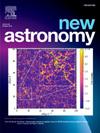Potential optical astronomical sites in less developed countries
IF 2.1
4区 物理与天体物理
Q2 ASTRONOMY & ASTROPHYSICS
引用次数: 0
Abstract
A “suitability index for astronomical sites” (SIAS) has been proposed to more easily select the best sites in the world as regards cloud cover, elevation, and artificial light. The SIAS brings new and great potential for countries with few resources, typically less developed countries (LDCs). However, it lacks crucial quantitative astronomical seeing information, quite expensive to gather (for this, we have developed a new technique and portable instrument to lower the costs of measuring the seeing). Good seeing exists on the up-wind edge of a mountain top with a greater than 1:3 slope angle towards laminar flow dominating winds (coastal sites or small islands). By inspecting with Google Earth the terrain and surrounding area of each SIAS-selected candidate site as regards the mountain height and slopes, the distance from the nearest sea/lake, and its mountainous neighborhood, we have shortlisted the best 13 sites for optical astronomy in eight LDCs.
欠发达国家潜在的光学天文站点
提出了一个“天文观测点适宜性指数”(SIAS),以便在云量、海拔和人造光方面更容易地选择世界上最好的观测点。SIAS为资源匮乏的国家,特别是欠发达国家带来了新的巨大潜力。然而,它缺乏关键的定量天文观测信息,收集起来相当昂贵(为此,我们开发了一种新技术和便携式仪器,以降低测量观测的成本)。在朝向层流主导风的坡度大于1:3的山顶逆风边缘(沿海地区或小岛)存在良好的能见度。通过与谷歌Earth一起检查每个sias候选站点的地形和周围区域,包括山的高度和坡度,距离最近的海/湖的距离,以及它的山区,我们在8个最不发达国家中选出了13个最佳的光学天文学站点。
本文章由计算机程序翻译,如有差异,请以英文原文为准。
求助全文
约1分钟内获得全文
求助全文
来源期刊

New Astronomy
地学天文-天文与天体物理
CiteScore
4.00
自引率
10.00%
发文量
109
审稿时长
13.6 weeks
期刊介绍:
New Astronomy publishes articles in all fields of astronomy and astrophysics, with a particular focus on computational astronomy: mathematical and astronomy techniques and methodology, simulations, modelling and numerical results and computational techniques in instrumentation.
New Astronomy includes full length research articles and review articles. The journal covers solar, stellar, galactic and extragalactic astronomy and astrophysics. It reports on original research in all wavelength bands, ranging from radio to gamma-ray.
 求助内容:
求助内容: 应助结果提醒方式:
应助结果提醒方式:


